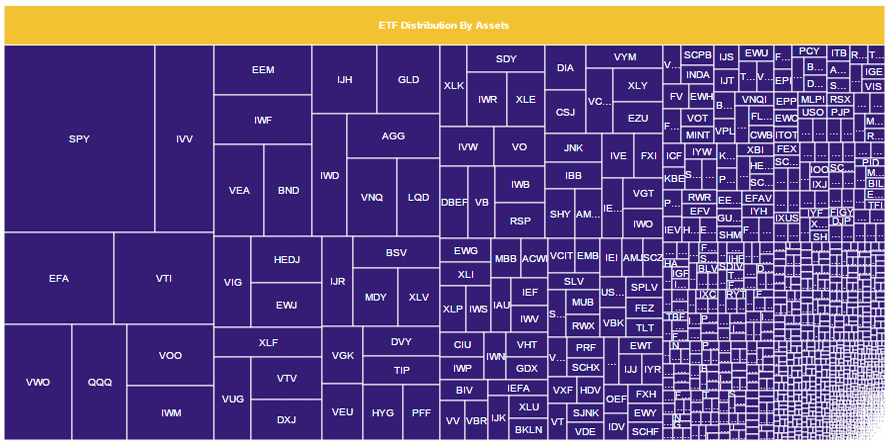
You don't need them.
The remarkable success of the ETF industry has been well documented. Assets of more than $2 trillion are now spread across some 1,765 products. The distribution of those assets, however, is far from even. The 20 largest funds make up nearly 40 percent of total assets. The smallest 900 ETFs combine to make up 1 percent of the total.
The image below illustrates the relative size of the 1,765 U.S.-listed ETFs that were available as of July 2015.

There are a number of reasons for the top-heavy nature of the ETF industry, as visualized above. The first mover advantage has definitely contributed, as has the brand awareness of some of the large issuers. But there is a more meaningful reason behind the concentration illustrated above:
Most of the 1,765 exchange-traded products have little in assets because they aren’t useful to most investors.
The increase in the number of exchange-traded products has come primarily in the form of funds with names like the Biotechnology Clinical Trials Fund (BBC) and the Spot CBOE VIX Fund Up Shares (VXUP).
Both BBC and VXUP are innovative products that offer efficient access to a very specific strategy. For those looking to overweight biotech stocks or hedge against short term market volatility, they will be incredibly useful. For those building a low-cost, low-turnover, long-term portfolio, they’re utterly useless. The same goes for about 1,700 other exchange-traded products.
From 1,765 to 13
If you’re convinced of the benefits of building an ETF portfolio but overwhelmed by the hundreds of hyper-targeted funds, the following tables may provide some relief. If the goal is a low-cost, long-term buy-and-hold portfolio there are about a dozen relevant ETFs. The other 1,750 or so can be completely ignored without missing anything.
Most portfolios will contain significant exposure to the U.S. stock market. Below are three ETFs that offer exposure to thousands of stocks of all sizes across all sectors of the economy (for 10 basis points or less).

Though many of the stocks found in the above ETFs offer indirect exposure to international markets (i.e., they hold stocks that generate parts of their revenue from outside the U.S.), most portfolios will also make explicit allocations to foreign stocks as well.
This section of the portfolio is typically split between developed markets (typically including Western Europe and Japan) and emerging economies (such as China and India). Below are three good options for developed market exposure.

The same issuers offer complementary products targeting emerging markets, all of which cost just a few basis points more.

The other primary component of a long-term portfolio is fixed income. The easiest way to complete this allocation is through an aggregate bond ETF that includes Treasurys, corporate bonds, high-yield bonds, and some mortgage-backed securities. Below are three options.

While many portfolios will focus just on U.S. bonds, others may prefer to include international exposure as well. If you want to round out the bond allocation with some international securities, the Vanguard International Bond ETF (BNDX) will do nicely. The expense ratio of 0.19 percent makes it the most costly among the 13 “building block” funds mentioned here.
Keeping It Simple
The tables above hopefully provide a simplified roadmap for establishing a basic all-ETF portfolio appropriate for a long-term investor. For the most part, the 99.3 percent of ETFs not included aren’t toxic, flawed, or malicious products. They’re just unnecessary for the process of constructing a portfolio core. Many investors may desire some additional customization — such as tilts toward certain countries or types of bonds — that will require them to venture beyond the “building blocks.” But the key functionality of a portfolio can be achieved with just a handful of broad-based products.
The ETF universe is perhaps best compared to the items in a grocery store. A few shoppers may pick up Wildilicious™ Frosted Wild! Berry Pop Tarts or Mountain Dew Baja Blast. But there’s no requirement to toss those items in the cart, and a basic trip to pick up bread, milk, and eggs is still perfectly acceptable (and much healthier).
ETFs have become increasingly popular as tools for active traders and short-term speculators. But wading through the clutter to find the building blocks of a portfolio is doable and worthwhile for many.
About the Author: Michael Johnston
Michael Johnston is senior analyst for ETF Reference, and also serves as COO of parent company Poseidon Financial. His investment expertise has been featured in The Wall Street Journal, Barron’s, and USA Today, among other publications. He resides in Chicago.

Comments